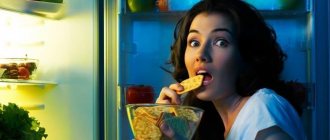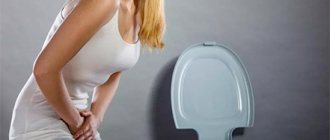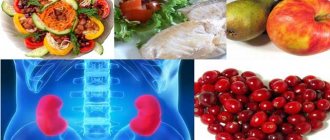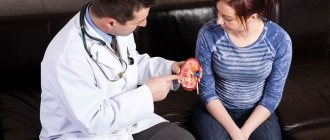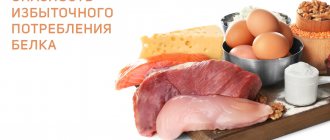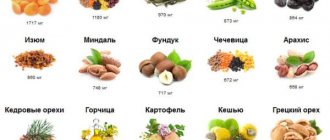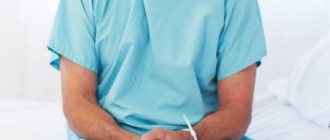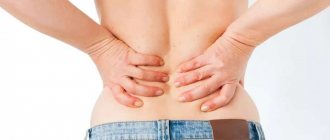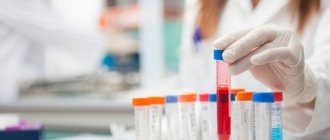Therapeutic nutrition for kidney disease
Any pathological conditions in the functioning of the kidneys, both acute and chronic, require the use of a special therapeutic diet.
Dietary nutrition for kidney disease should be aimed at restoring the water-salt balance in the body, preventing constant swelling of the legs, and improving the removal of under-oxidized metabolic products (toxins). Its main goal is to reduce the content of extractives in the diet that irritate the kidneys, and thereby provide the necessary anti-inflammatory effect, as well as improve metabolism.
Diet No. 7, which is prescribed for chronic nephritis in remission, acute nephritis during the recovery period, renal failure, tendency to edema, metabolic disorders and other renal pathologies, meets these requirements.
Today we will talk about the nuances of therapeutic nutrition for kidney diseases, give a list of permitted and prohibited foods and dishes, and advise how to cope without salt...
Prohibited Products
The list of prohibited products includes the following:
- Meat and fish broths. Protein substances remain in them.
- Alcohol and carbonated drinks, including beer and wine. They aggravate the human condition in pathologies. Drinking alcohol accelerates the breakdown of muscle fibers. Gases in drinks negatively affect the condition of the mucous membranes.
- Flour and confectionery products. Contains vegetable proteins. They are rich in fast carbohydrates, which is bad for your health. There are almost no useful substances in such products.
- Legumes. They are completely removed from the menu because they are rich in proteins.
It is recommended to avoid grains. In the absence of pathologies, you can limit their use. The proportion of milk, animal fats and eggs in the menu is reduced. In case of cirrhosis and kidney pathologies, any salty foods are removed from the diet. This applies not only to marinades and chips, but also to bouillon cubes, nuts in bags, etc. With chronic renal failure, the intake of potassium and phosphorus is limited.
Bread with bran, cheese, bananas, and chocolate are prohibited. Fast food is not consumed, regardless of health status.
Therapeutic nutrition for pyelonephritis
Since in the acute phase pyelonephritis is accompanied by an intense inflammatory process and intoxication, in the first 5-10 days you should adhere to a vegetarian diet based on fresh vegetables, fruits, and vegetable soups.
It is recommended to eat zucchini, beets, watermelons, carrots, baked apples, semolina and buckwheat porridge. Milk, eggs and lean fish are allowed in limited quantities. After reducing intoxication and inflammation, you can add some meat dishes to your diet.
In addition, it is important to maintain a drinking regime, since a lack of fluid provokes the formation of kidney stones and stagnation of cell waste products. The menu should contain enough healthy fats and carbohydrates against the background of a slight protein deficiency.
Therapeutic nutrition for pyelonephritis cannot contain smoked, fried and spicy foods, as well as pickles and industrial canned food. You can eat lean fish, beef, rabbit, chicken, and turkey. Whole grain porridge, fresh vegetables and diluted fruit juices are healthy.
Advantages and disadvantages
The main advantages of the medical nutrition system:
- helps reduce protein load,
- stimulates the restoration of kidney and liver functions,
- prevents the concentration of nitrogenous compounds in the blood serum,
- helps improve overall well-being,
- stimulates detoxification processes.
The disadvantages include the following:
- sometimes inhibits the activity of plastic processes,
- when there is a deficiency of microelements and vitamins in the diet, the function of the immune system weakens,
- increased fatigue and a feeling of weakness may occur,
- mood worsens,
- Diet can cause significant muscle loss.
How to do without salt
Those who are accustomed to salting everything may think that a diet without salt is very tasteless and bland, but this is not at all the case.
To easily manage without sodium chloride, use the following tips:
Don't know what to cook as part of your salt-free diet? Here is a sample menu for the day:
Stick to this diet if your doctor recommended table number 7 and follow his other recommendations. Good health to you!
Do you want to learn all the nuances of therapeutic nutrition for various diseases so that you can easily manage any client or become a nutritionist for your family? Then pay attention to the new course of the Wellness Consulting Academy “Therapeutic and health-improving nutrition for various diseases.”
It is very important for us to know your opinion on the topic you just read. Be sure to share with us in the comments what topics on clinical nutrition you would like to read more articles on?
Also, don’t forget to like us for our efforts in writing the material. We value your every heart. The more we have, the more joyfully we write new articles.
Source
Recommendations from nutritionists
Maria Anatolyevna, 52 years old, nutritionist A protein-free diet is a therapeutic diet that is prescribed for gout, chronic renal failure, oncology and other diseases.
You cannot switch to it on your own, since this is fraught at best with exhaustion, and at worst with the development of chronic pathologies due to a lack of amino acids. The latter are building materials for the body, therefore they are required by all people for normal life. Svetlana Vladimirovna, 45 years old, nutritionist Reducing protein in the diet is justified only if a person has medical indications. To lose weight, it is strongly recommended to reduce the proportion of carbohydrates and pay attention to the quality and quantity of fat consumed. The body needs all macronutrients. With a low-protein diet, the human body suffers from amino acid deficiency, but in some pathologies the benefits outweigh the risks. Healthy people do not need to risk their health.
General rules
Proteins are complex nitrogen-containing biopolymers consisting of amino acids . They perform plastic, hormonal, catalytic and transport functions. The importance of the protein component in nutrition lies in the fact that it serves as a source of amino acids, which are divided into replaceable and essential. Replaceable amino acids may not be present in the diet, since they are formed in the body from other substances, and the intake of essential amino acids from food is mandatory.
Recently, many foreign experts are more inclined to believe that a low but adequate protein content in the diet is more justified than its high consumption. They suggest that the norm for its consumption is 0.84-0.86 g/kg of weight, that is, a person weighing 70 kg needs 60 g of protein per day. In Russia, a fairly high level of consumption is recommended - 85-90 g per day.
For healthy people, a protein-free diet for weight loss is not recommended for a long time (maximum 7 days), as it can be harmful to health. Proteins are necessary for many body functions and their sharp restriction is recommended only for medical reasons and under the supervision of a physician. Insufficient dietary intake slows down the synthesis of albumin and muscle protein, while at the same time the degradation of amino acids continues. Muscles lose amino acids, which are used for the energy needs of the body.
In addition, you should not count on significant weight loss, since you cannot significantly increase the load during this period so as not to cause loss of muscle mass. In addition, eating bread, pancakes, pancakes, cereals and pasta, honey, jams, preserves, which are recommended for this period, is unlikely to cause weight loss.
The calorie content of the diet ranges from 2000-2100. According to the rules of a protein-free diet, you also need to consume milk, dairy products, butter, vegetables, fruits, and herbs. The daily protein portion can consist of a glass of milk or a piece of cheese up to 30 g or a glass of yogurt. Salt is limited to 2 g.
For people who do not have diseases, it is better to refuse such a diet in order to lose weight. It is more rational to introduce a protein-free diet once a week as a fasting. Low-protein diets and fasting are accompanied by catabolic processes, and a negative nitrogen balance occurs. This diet is contraindicated for people leading an active lifestyle or athletes.
In some diseases, protein consumption is limited for medical reasons. The most dangerous thing is an increased protein load in kidney and liver diseases. This nutrition is prescribed, for example, for uremia , when the excretion of nitrogen-containing compounds is reduced or liver failure in order to prevent hepatic coma.
A diet without proteins (it is called so conventionally, since proteins are not eliminated from the diet at all, but their consumption is limited) is recommended for diseases and belongs to the category of therapeutic diets. Nutritional therapy is of particular importance in cases of renal failure , a condition in which, for various reasons, impaired renal function occurs. It has been established that consuming 0.5-0.6 g of protein per 1 kg of weight (35-40 g for a weight of 70 kg) in chronic renal failure allows the body to better remove nitrogenous waste.
Reviews and results
Marina, 37 years old, Voronezh. She set a goal for herself - to lose 5 kilograms by summer.
Beach season was approaching, so I needed to look good. I went on a protein-free diet and began to exercise intensively. I felt terrible, but I was happy to lose 2 kg in the first few days. By the end of the week the goal was achieved, but at great cost. When I began to evaluate the results, I realized that I had suffered in vain. The number on the scales has changed, but the skin has sagged and the defects have worsened. Elena, 34 years old, Krasnodar I wanted to lose weight on a protein-free diet, but did not read the information in advance. I've been struggling with the consequences for six months now. In the first days I lost 3 kg. Now I understand that due to water and limiting salt. A week later, my health deteriorated greatly and I felt weak. After 2 weeks I could barely get out of bed, but I had already lost 5 kg, so I decided to continue. A month later I had to see a doctor: I returned to my previous diet, but began to suffer from digestive disorders, and my condition only worsened. The doctor scolded me and said that the weight I lost was muscle.
Diet for kidney failure
All iLive content is reviewed by medical experts to ensure it is as accurate and factual as possible.
We have strict sourcing guidelines and only link to reputable sites, academic research institutions and, where possible, proven medical studies. Please note that the numbers in parentheses ([1], [2], etc.) are clickable links to such studies.
If you believe that any of our content is inaccurate, out of date, or otherwise questionable, please select it and press Ctrl + Enter.
Such basic functions of the kidneys as metabolic, excretory, hematopoietic and ion-regulating largely depend on what material, roughly speaking, they have to deal with.
That is, the products that enter the body can have a rather negative effect even on healthy kidneys, and in the event of renal failure, additional irritation of the kidneys is generally unacceptable. Therefore, diet plays not just an auxiliary role in treatment, but one of the decisive ones. The main function of the diet for renal failure is to prevent the breakdown of proteins contained in tissues and organize the most gentle mode of kidney function.
Kidney failure is a condition in which all kidney functions are impaired, which in turn leads to disruption of the exchange of nitrogen, water and electrolytes in the body. This condition can be acute or chronic. In any case, the most important element in the treatment of kidney failure is diet. In this case, kidney failure can be caused by various reasons, but regardless of this, the kidneys cannot cope with their function normally.
But of course, diet in this case cannot be the only method of treatment, since it is necessary to replace the kidney functions that have been impaired using medical procedures such as hemodialysis and peritoneal dialysis. If kidney function cannot be restored, organ replacement is required. In case of kidney transplantation, diet is also mandatory.
[1], [2], [3], [4]
Protein-free diet according to Andreas Moritz
This technique has gained great popularity, as it is divided into separate stages, described in detail in the list below:
- preliminary preparation , which is based on the daily consumption of apple juice in the amount of 1 liter for 6 days. The liquid effectively cleanses the body and flushes the bile ducts. The product should be drunk between meals and should not be used before bedtime;
- if you are allergic to apple juice, it must be replaced with loosestrife tincture, which can be purchased at a pharmacy.
The use of the technique implies the exclusion of taking medications, biological additives, animal fats, fried and dairy products;
- The main stage of the diet is to take oatmeal for breakfast and boiled rice for lunch . When 14.00 comes, you must completely stop eating. You can drink purified water and a solution with salt, divided into 3 doses. Before going to bed, you need to prepare a mixture of grapefruit and lemon juice with 125 ml of olive oil. Drink the resulting liquid at 22.00;
- at the final stage, take the final portion of the previously prepared solution, and eat light food for lunch. To obtain the proper result, the process is carried out 5–7 times.
Necessary recommendations
Before you start following a protein-free diet, you should pay attention to the following tips:
- obtaining the approval of the attending physician;
- using safe cooking methods (steaming, baking, stewing);
- the maximum time for using the diet should not exceed two weeks;
- compliance with bed rest, if necessary (in the acute course of a chronic disease);
- parallel use of complexes with the maximum content of vitamins and essential microelements, which have a positive effect on the recovery of the body.
In terms of quantitative content, the daily diet should have the following proportions:
- 25–30 grams of protein;
- 60–65 grams of fat;
- 350–360 grams of carbohydrates.
A person's need for protein per 1 kilogram of body weight in the muscle layer is 2 grams. Over a set period of diet, you can lose 5–7 kg. At the same time, the main task of a limited diet is to cleanse the body and prevent the development of potential or chronic diseases.
What diet for kidney failure?
In any case, if kidney function is impaired, restrictions on the amount of protein consumed are mandatory. But the question remains about how exactly to limit it, what protein content is optimal. Because it is impossible to allow the body to begin to destroy its own tissues to produce protein in order to build itself. With the possible variety of foods that can provide the increased daily calorie intake necessary for kidney failure, it is very important to take into account that other diseases can limit all these options. For example, gastritis, cholecystitis, pancreatitis. Although it should be noted that, in general, all dietary diets are designed to be safe for the body as a whole.
In case of renal failure, the diet should be selected in such a way that the patient can eat tasty food. Due to impaired kidney function, taste preferences are greatly distorted, and you also have to give up salt and usual sugar substitutes, such as dried fruits and bananas. Therefore, you should try to diversify your cooking with various sauces, dressings, spices, and vegetables with a specific taste.
How to make a menu correctly
When starting any diet, it can be quite difficult to get started. The whole difficulty lies in studying the permitted products and forming from them a suitable menu that meets the goals of adhering to a certain nutritional system. To simplify this task, you can first use the basic diet options.
If a person nevertheless decides to go on a protein-free diet for weight loss, his menu for the week will consist of small mono-diets.
- Monday and Tuesday are a vegetable feast. During this period, you can eat up to 2 kg of cucumbers, tomatoes, peppers, etc.
- Wednesday is dedicated to pears and apples. Including them in your diet will improve your metabolism.
- Thursday will consist exclusively of steamed vegetables and jam.
- On Friday and Saturday you can eat yogurt, vegetables and dishes made from them.
- Sunday – we eat only greens and vegetables.
Such a strict regime can help you get rid of 7 to 10 kg per week, but health problems cannot be ruled out.
Following a low-protein diet for medicinal purposes can begin with the following menu:
Category of peopleBreakfastSecond breakfastLunchDinner
| With kidney diseases (weight loss by 5-7 kg) | 2 eggs (white) + 2 tomatoes + 200 ml milk. | Dried fruits. | Vegetable stews or fruit salads. | Vegetable salad. |
| With cancer (2 weeks) | 100 gr. buckwheat porridge on water. | Apples. | Bread with boiled vegetables. | Buckwheat porridge + 2 tomatoes. |
| Diabetics (no more than 1 time in 2 months) | Cabbage salad + tea. | Tomato or cucumber. | Pasta + boiled vegetables. | Beet salad dressed with vegetable oil. |
| With rheumatoid arthritis (2 weeks) | Buckwheat porridge with milk + 1 carrot cutlet + a cup of tea without sugar. | Fruits or vegetables. | 2 boiled potatoes + vegetable soup + compote. | Lenten pilaf + vegetable salad + a cup of jelly. |
| Pregnant women (2 weeks; minus 5 kg) | 100 gr. buckwheat porridge + 2 apples. | Yogurt. | Pancakes + pasta + milk. | Vegetable stew or salad. |
| Nursing mothers (no more than 1 week; up to 4 kg may be lost) | 100 gr. semolina or buckwheat porridge with milk + jelly. | Fruits or vegetables. | 2 boiled potatoes + lean soup. | Vegetable salad. |
Diet 7 for kidney failure
When choosing a diet in case of renal failure, you can create a diet individually for an individual patient. But at the same time, you can use existing schemes. The most common in use are dietary tables developed by Pevzner. Among them, for renal failure, dietary table No. 7 is recommended. This table is designed for patients with kidney problems. At the same time, diet No. 7 also contains a more detailed division depending on the stage and type of kidney disease. So there are dietary tables No. 7a, 7b, 7c, 7d and 7p.
Dietary table No. 7 is prescribed to a patient with acute glomerulonephritis, who is at the recovery stage, or with chronic subsiding glomerulonephritis. This diet is also indicated for nephropathy in pregnant women.
This diet allows you to facilitate the process of removing under-oxidized metabolic products and nitrogenous waste from the body, create a gentle regime for the kidneys and reduce arterial hypertension.
Of all the seventh group diets, this one is the richest in protein. Up to 80 g of protein is allowed, half of which can be of animal origin, 90 g of fat, about 450 g of carbohydrates, free liquid - 1 liter. Salt The amount of salt is limited to 6 g. The diet is quite high in calories - 2750 - 3150 kcal per day, which allows you to maintain the active functioning of all body systems.
Products should be cooked boiled, although frying after cooking is allowed. The food is crushed. Substances that irritate the cardiovascular and central nervous systems are not allowed.
[5], [6], [7], [8], [9]
Indications for dieting
The main indications for prescribing a therapeutic diet include cancer, kidney disease and pathologies of the lymphoid tissue of the brain. Sometimes protein intake is limited due to liver disorders. Short-term reduction of the proportion of amino acids in the menu with high blood pressure.
Oncological diseases
Scientists suggest that proteins serve as food for cancerous tumors. The latter produce energy during the fermentation of amino acids. Experiments have shown that the growth of tumors does not stop even with an 80% restriction of meat products on the menu. It is believed that casein stimulates the development of tumors most of all. Some doctors also advise reducing the proportion of methionine in the menu. Without it, the growth of tumors in the mammary glands is impossible.
It is not recommended to completely give up protein, despite research results, since tumors will receive amino acids from muscle tissue. However, moderate restriction slows down the growth of tumors.
Kidney diseases
With kidney disease, their ability to filter deteriorates. This means that metabolic products are removed from the body more slowly. This primarily concerns creatinine, a by-product that is formed during the breakdown of protein molecules. This compound has no functional purpose and is harmful to the body. When it increases, a person experiences muscle pain, weakness, and swelling. To prevent the accumulation of creatinine in tissues, the amount of protein consumed is reduced so that diseased kidneys have time to cope with its excretion.
Pathologies of brain lymphoid tissue
Most often, pathologies of the lymphoid tissue of the brain are oncological in nature. In this case, exclusion of proteins is required to slow down the growth of tumors and prevent the emergence of new lesions.
When following a protein-free diet, you must strictly follow its basic rules.
Diet for chronic renal failure
In case of chronic renal failure, the diet is selected depending on the patient’s condition, the stage of development of the failure, and the duration of the last period of exacerbation. Most often, standard regimens are chosen, which can then be adjusted depending on the needs of a particular patient.
But usually, in case of chronic renal failure, diet table No. 7 or 7a is chosen. Also, in some cases, diets No. 7, 7a, 7b are combined, using them alternately. Dietary table No. 7a is prescribed in case of exacerbation of chronic processes of renal failure. This diet is prescribed only for short periods of about a week. If chronic renal failure is in remission after an exacerbation, then diet No. 7b with a gradual transition to diet No. 7 would be more appropriate.
In any case, all dietary regimens for chronic renal failure are aimed at reducing protein consumption to one degree or another to reduce azotemia, be gentle on the kidneys, and also maintain such a balance of protein in food so that, while reducing the load on the kidneys, the destruction of the proteins of the body itself is prevented .
Diet No. 7a is the most limited in protein composition, only 20 g of protein, 80 g of fat, 350 g of carbohydrates are allowed. Salt is limited to 2 g. The volume of liquid consumed, as with diet 7b, should be 200 - 300 ml more than the volume of urine excreted. The energy value of the diet is 2200 kcal. Food is boiled, fried, baked. Salt is strictly limited.
[10], [11], [12], [13], [14]
Authorized Products
The menu includes the following dishes:
- Lean meats: beef, chicken, veal and turkey. It is recommended to boil them first, then bake if desired. The size of one serving is 55-60 g. The meat is served along with vegetable side dishes.
- Low-fat fish: cod, pike perch, pike, pollock, etc. It is preferable to first boil the product, then bake it or eat it as is.
- Vegetarian soups. They are prepared without the use of rich broths. It is allowed to add vegetables or cereals, but not meat. Serving size is 250-300 ml.
- Bread. Only a special protein-free one will do. It is eaten with other dishes.
- Vegetables. Salads and side dishes are prepared from potatoes, cucumbers, cabbage, carrots, beets and tomatoes. In the second case, vegetables are stewed or boiled. It is allowed to decorate dishes with dill, parsley and green onions, if there are no kidney pathologies. If there are diseases, any products with essential oils should be removed from the diet.
- Eggs. Protein omelettes are prepared from them. Serving: 1 egg. You can add butter or vegetable oil to the dish.
- Sago. Serves as a replacement for standard side dishes: pasta, cereals and legumes. Sago does not contain protein or gluten, so it is often added to the diet for therapeutic nutrition. The product is used to prepare casseroles, pies, porridges, cutlets, etc.
- Berries, fruits and dried fruits. The latter are limited in case of chronic renal failure. Additionally, in case of pathology, fruits and berries are consumed only in boiled form, compotes, fruit drinks, etc. are prepared from them. This is due to the need to reduce the proportion of potassium consumed. In other cases, berries and fruits are allowed to be eaten raw.
- Fermented milk and dairy products. You are allowed to eat up to 50 g of cottage cheese or up to 200-300 g of kefir, fermented baked milk, homemade yogurt or any equivalent per day.
- Beverages. Rosehip infusion, natural vegetable and fruit juices, coffee and tea are suitable.
On a diet, it is recommended to eat foods that contain a minimum of protein, and it is forbidden to eat those that contain a lot of it.
Diet recipes for kidney failure
[21], [22], [23]
Vegetarian borscht
Wash the beets, peel them and place in boiling water. Cook until half cooked. After that, remove the beets from the broth, let cool and grate on a coarse grater.
Peel the onion, carrot and tomato, chop finely and simmer in oil.
Place peeled and diced potatoes into the boiling beet broth, and 10 minutes later add cabbage. When the cabbage is cooked, add the stewed carrots, onions and tomatoes. Bring to a boil, add sugar. Before serving, season the borscht with sour cream and herbs, and add some salt.
[24], [25]
Carrot cutlets
Boil the carrots, cool, peel and grate on a fine grater. Then add 50 g of semolina, mix well, add sugar, add salt if desired. Form cutlets from the resulting mass and roll them in the remaining semolina. Fry in vegetable oil for 3 minutes on one side, then turn over to the other, reduce the heat, cover and fry for another 10 minutes. Serve with sour cream and herbs dressing.
When choosing a diet for renal failure, you should base it not only on the diagnosis itself, but also on the degree of renal failure, acute or chronic stage of the disease, calculation of the concentration of proteins in the food itself and at the same time the content of protein metabolism products in the blood, general electrolyte balance, the presence of concomitant diseases in the patient.
[26], [27]
Dish recipes
To make the menu more attractive, you can try cooking a few new dishes.
Milk porridge with jam
To prepare porridge, take 0.5 liters of milk, 180 g of wheat cereal, rice or oatmeal and 1 tbsp. l. jam. Milk is poured into a saucepan, a little water is added, and put on fire. After boiling, add the cereal and cook for 15-20 minutes, stirring. After the stove is turned off, the porridge is covered with a lid, allowing it to evaporate. Add jam before serving.
Vegetable pickle
To prepare you will need 2 pickled cucumbers, 3 potatoes, 1 carrot, 80 g of rice, parsley, dill, 1 onion and bay leaf. Place a pan of water on the fire, bring to a boil, add all the vegetables, cut into small cubes, except cucumbers. The latter are introduced 10 minutes before readiness along with the herbs, then simmer the dish over low heat.
Stewed zucchini with tomatoes and peppers
To prepare the dish you will need 2 zucchini, 1 sweet potato, 2-3 tomatoes, 1 onion and 1 tbsp. l. vegetable oil. Peppers and zucchini are cut into half rings, and the onion is chopped. Vegetables are sautéed in a frying pan with a small amount of oil. Tomatoes passed through a meat grinder are added to the mixture after 7 minutes, then all ingredients are simmered under a closed lid for 10 minutes. The finished dish is decorated with herbs.
Despite significant restrictions, with a protein-free diet you can eat tasty and satisfying meals.
Vegetarian pilaf
To prepare vegetarian pilaf you will need 2 tbsp. rice, 1 can of canned corn, 1 onion, 2 carrots, 2 tbsp. l. tomato paste and 2 tbsp. l. vegetable oil. First, finely chop the onion and grate the carrots. The mixture is simmered in a frying pan for 5 minutes, then tomato paste and corn are added. After 5 minutes, pour the soaked rice into the frying pan, mix the ingredients and pour boiling water so that the water covers the vegetables. Simmer everything together under the lid for half an hour.
What can you eat if you have kidney failure?
The kidney maintains the balance of water in the body, controls the content of microelements, and removes waste, including nitrogenous ones. If renal failure occurs, nutrition should be organized in such a way as to reduce to the possible minimum those substances in the body that the kidneys have to cope with, since during this period their functions are impaired.
Nevertheless, it is important to maintain a healthy diet, saturate the weakened body with the amount of energy it needs, and consume large amounts of vitamins and other useful substances.
Therefore, a diet for kidney failure involves consuming various fats, except those that are poorly soluble and can have a negative effect on other organs (for example, lamb fat, palm oil). Also, food should be rich in carbohydrates. To do this, your diet should include various cereals, which are consumed boiled, in soups, in the form of casseroles and puddings.
Also, to provide the necessary set of vitamins, fiber and calories, you should diversify your food with various vegetables, fruits, berries, and sweets. Vegetables should preferably be familiar. Potatoes, carrots, cauliflower, leafy green vegetables, zucchini, and pumpkin work well. They can be used as part of vegetarian soups, stewed, boiled, fried, or steamed. Berries and fruits can be prepared in the form of compotes, soups, jams and mousses.
Protein-free diet: list of products
In its strict form, a protein-free diet excludes almost all components of animal origin, replacing them with mixtures and essences containing the necessary complex of amino acids.
Most nutritionists create a more gentle and balanced version of the diet, where some animal proteins are present.
Authorized Products
| № | Name | Scroll |
| 1 | Bakery products | Bran, white protein-free bread, cereal flakes, crispbread |
| 2 | Meat fish | Lean turkey, rabbit, hake, pollock, pike |
| 3 | Egg | One a day |
| 4 | Vegetables | Almost all |
| 5 | Cereals | Any pasta other than regular legumes (peas, chickpeas) |
| 6 | Fruits | Everything except melon and watermelon |
| 7 | Oils | Vegetable, flaxseed, olive |
| 8 | Milk | Low-fat milk, kefir |
| 9 | Beverages | Tea, coffee (in limited quantities), compotes, jelly, herbal and berry infusions |
| 10 | Sweet | Honey, preserves, jams, jellies |
Prohibited Products
| № | Name | List |
| 1 | Animal fats | Butter, ghee, margarine, lard |
| 2 | Meat | Chicken, beef, pork |
| 3 | Milk | Full-fat sour cream, cottage cheese, cheese, cream |
| 4 | Bakery products, sweets | Baked goods, shortbread, biscuits, sweets, cakes, regular bread |
| 5 | Vegetables | Radish, daikon, radish, garlic, horseradish, pumpkin, hot pepper |
| 6 | Beverages | Soda, alcohol |
| 7 | Other | Marinades, canned food, mushrooms, soy, nuts, seeds, chips, smoked meats |
Protein-free diet: weight loss results
Anna, 27 years old
“I tried low carb for about 10 days. It was not easy, but I managed to endure it. I practically didn’t eat meat, eggs, white bread or pasta. True, I couldn’t completely give up salt; I added a little to porridge and soups. I was able to lose 3.5 kilograms, but the weight began to return again. So the game wasn’t worth the candle.”
Elena Petrovna, 44 years old
“I followed a special diet for a week on the doctor’s recommendation. I have acute renal failure, I can’t do it without diet. They said you need to avoid consuming foods that contain a lot of potassium - bananas, nuts, broccoli. I ate porridge, boiled vegetables (potatoes, carrots, zucchini), cornmeal bread and some fish. I excluded everything salty and fatty. I even had to buy a double boiler, and now I cook everything only in it. I felt lighter and began to swell less. I want to repeat the course in six months.”
Christina, 21 years old
“Diets are a sore subject for me, I’m always trying to lose weight. I chose this one because I eat little meat and don’t like cottage cheese or cheese. But I was only able to eat like this for 5 days; food without salt turned out to be very tasteless. I didn’t want to cook anything; I ate almost nothing but raw vegetables and fruits. In recent days, my stomach has been very sick, my stool has become irregular, and I have become irritable. To my surprise, I lost 1.5 kg. But I don't plan to continue. I will look for other options.”
Artemy, 39 years old
“A low-protein diet without salt is very difficult to tolerate. Even seasonings don’t help me; the food seems absolutely tasteless. But this is how my doctor prescribed me to eat. Any canned food, marinades, fried potatoes, or store-bought semi-finished products are prohibited. Now my wife cooks for me separately, steaming everything. I’ve been following the regime for 7 days now, there’s not much left. But I feel better, that’s why I’m holding on.”
Sources
- https://Dietonika.com/diety-dlya-pohudeniya/drugie-diety/bezbelkovaya-dieta-spisok-produktov.html
- https://nadietu.net/weight-loss-diet/other-diets/bezbelkovaya.html
- https://VReticule.com/life/health/pitanie/bezbelkovaya-dieta/
- https://mrsovet.ru/diety/bezbelkovaya-dieta.html
- https://abgym.ru/diety/razlichnye-vidy/bezbelkovaya.html
- https://gidbody.com/problemy-s-vesom/diety/smeshannye/nizkobelkovaja
- https://hudetprosto.com/nizkobelkovaya-dieta

